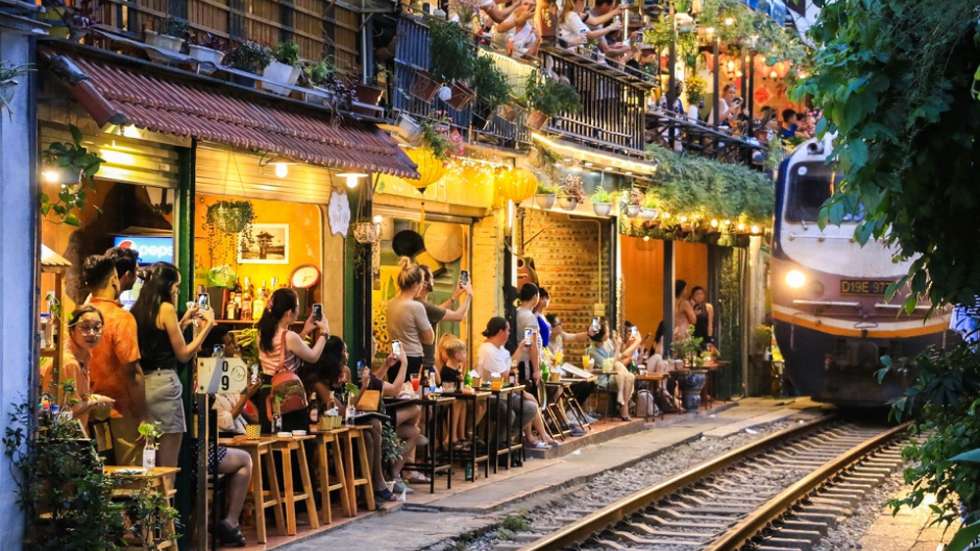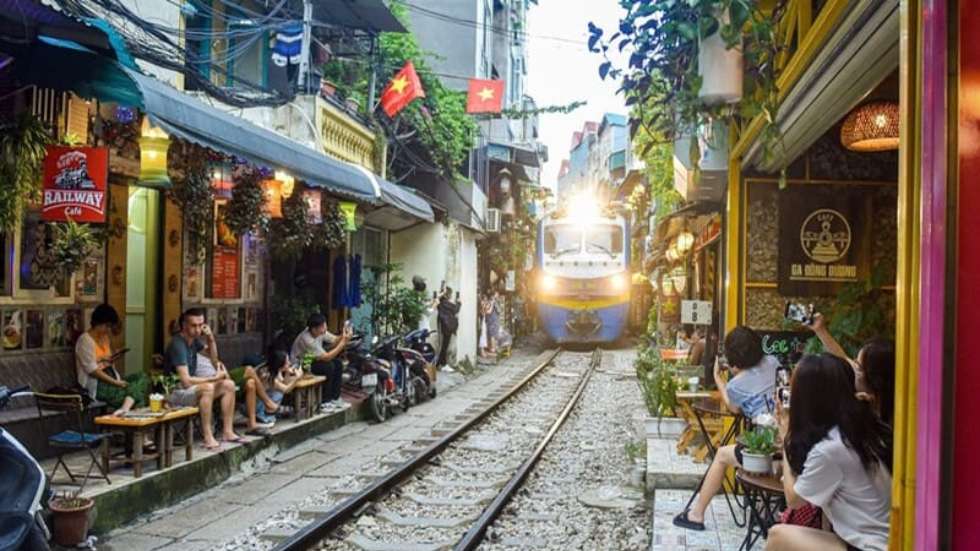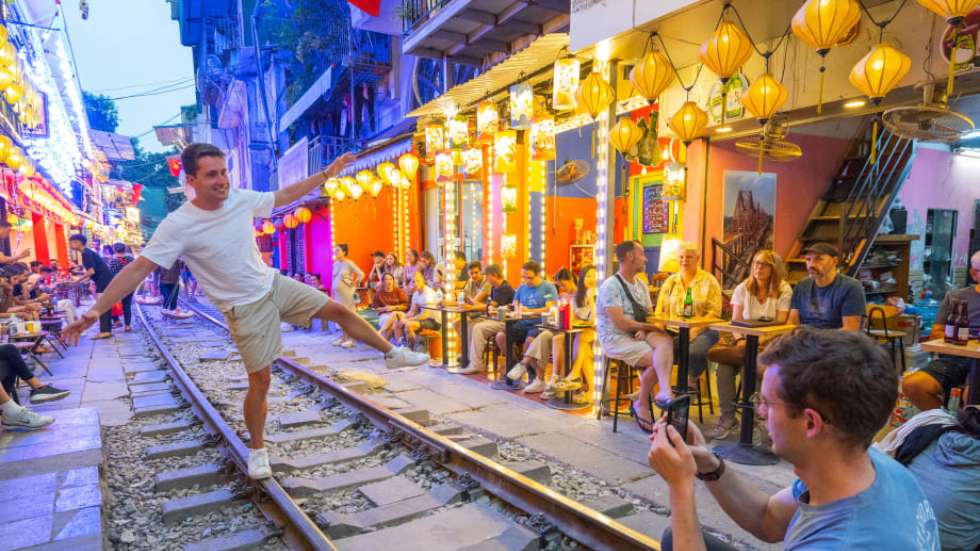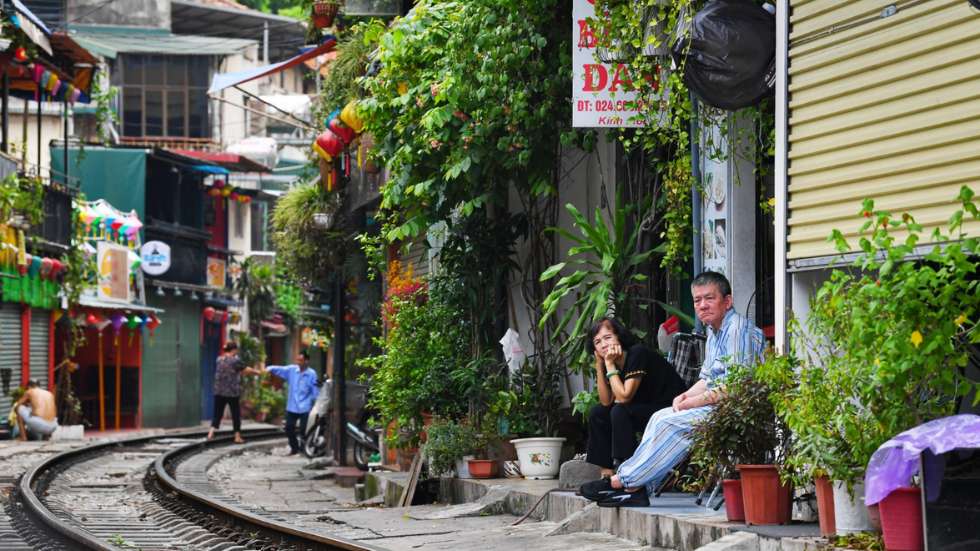LOGIN - TOURISM PROFESSIONALS
Trusted & professional DMC & Tour Operator in Vietnam
WITH A PROFESSIONAL ACCESS, YOU WILL HAVE ACCESS TO:
- Our complete production (tours, excursions and personalized modules).
- Our Toolbox (unique documents about each of our destinations that will help you in providing detailed information to your clients).
- Our highlights, recommendations, newsletters and many other practical contents.
The Ultimate Guide to Hanoi’s Train Street
Hanoi’s Train Street, known locally as “Phố Đường Tàu,” is nestled in the Old Quarter on Hang Bac Street. This narrow 200-meter alley also passes through Lê Duẩn and Khâm Thiên streets, just a few blocks from the famous Hoàn Kiếm Lake. It is surrounded by traditional residential buildings and small local businesses, creating a genuine slice of everyday life in Hanoi.
What's special about the train line is its sheer proximity to an active railway line. The train runs almost parallel to the buildings, giving visitors a rare chance to see modern transit up close, a spectacle that is both thrilling and photogenic. Over the years, this unexpected fusion of modern machinery with historic surroundings has become an iconic attraction in Hanoi.
Historical and Cultural Context
The story of Hanoi’s Train Street dates back to the early 20th century when the French colonial authorities developed the railway system to connect Hanoi with northern provinces. As the city expanded, buildings sprang up around the rail tracks. Today, these tracks serve as a living reminder of Hanoi’s evolving urban landscape, blending its colonial past with its dynamic present.
Local residents have adapted remarkably to this unusual setting. What might seem dangerous at first glance has long been integrated into daily life, with both locals and visitors following established safety practices. This adaptability has made Train Street not only a unique photo opportunity but also a vibrant piece of urban heritage.

Source: Internet
Experiencing the Sensory Magic
Vivid Visual Impressions and Correct Train Timings
When you approach Train Street on Hang Bac, the first thing you notice is the dramatic interplay of light and shadow. In the early morning or at sunset, the alley is bathed in soft, golden light that accentuates the textures of aged bricks and faded murals on the building facades. The train, a modern locomotive, speeds by with a burst of motion, creating a striking visual contrast against the static, historic structures.
Accurate timing is crucial. According to local information, the train typically passes through around 3:30 PM in the afternoon and again at 7:30 PM in the evening. These timings, however, can occasionally vary, so it is wise to check local updates or ask nearby vendors when planning your visit. Arriving a few minutes early allows you to secure a good viewing spot and absorb the full spectacle of this urban phenomenon.
The Enchanting Soundscape
Beyond the striking visuals, the auditory experience on Train Street is equally compelling. The rhythmic clatter of the train’s wheels on the rails provides a constant, mesmerizing backdrop. This sound, combined with the ambient chatter of street vendors, the murmur of local residents, and the occasional tune drifting from a nearby café, creates a rich soundscape that encapsulates the spirit of Hanoi.
Each passing train adds a layer of energy to the street, transforming it from a quiet alley into a dynamic performance that unfolds twice a day. This blend of noise and silence, movement and stillness, is what makes Train Street a living, breathing part of Hanoi’s urban tapestry.
Understanding Train Timings and Daily Rhythms
What Time Do The Trains Run Through The Streets?
One of the most endearing aspects of Hanoi’s Train Street is its reliable schedule. The local train runs approximately twice daily, with the first passage typically at 3:30 PM and the second at 7:30 PM. This predictable rhythm allows locals and visitors alike to plan their visits around these magical moments.
The scheduled timings add a ritualistic quality to the experience. As mentioned earlier, two trains pass through Hanoi’s Train Street every day. The first train, SE19, leaves Hanoi Station at 15:20 and reaches Long Bien Station at 15:30, while the second, SE20, departs from Long Bien Station at 19:10 and arrives at Hanoi Station at 19:20. Keep in mind that the train schedule is subject to change without notice, so it’s best to verify the timings before your trip.
For the Le Duan section, the recommended viewing times are 3:30 PM and 7:30 PM. Since it gets dark during the second pass, visiting at 3:30 PM is advisable.
In the Old Quarter, train passes occur on weekdays at 7:00 PM, 7:45 PM, 8:30 PM, and 10:00 PM, while on weekends they run at 9:15 AM, 11:20 AM, 3:20 PM, 5:30 PM, 6:00 PM, 7:00 PM, 7:45 PM, 8:30 PM, 9:00 PM, and 11:00 PM.

Source: Internet
Planning Your Visit
We highly recommend preparing in advance. Confirm the train schedule with local vendors or on social media groups dedicated to Hanoi travel, as timings can occasionally shift due to operational adjustments. Arriving early is key—this gives you time to settle in, pick the ideal spot behind the safety markers, and enjoy the surrounding ambiance before the train roars by.
Careful planning transforms a simple visit into a deeply immersive experience, one that allows you to truly appreciate the harmonious coexistence of old and new.
Embracing Safety on Train Street
Local Safety Measures and Practices
Safety on Hang Bac Street is taken very seriously. Over time, the local community has implemented several measures to ensure that both residents and visitors can enjoy the spectacle without risk. Visible safety markers, including yellow-painted lines on the ground, clearly indicate safe zones where you should stand. These markers help maintain a secure distance from the tracks.
Local authorities also periodically close the street during train passages to allow for safe viewing. The presence of local security personnel further ensures that everyone adheres to safety protocols. This careful monitoring has made Train Street a controlled and safe environment, despite its seemingly precarious setup.
Our Essential Safety Tips
For your own safety, we suggest a few simple but important guidelines:
- Always stand behind the yellow safety lines.
- Avoid leaning over or approaching too close to the tracks.
- Arrive early to choose a safe viewing spot.
- Stay alert and heed any announcements or temporary safety instructions.
Following these guidelines, you can fully enjoy the excitement of watching the train pass by while keeping yourself secure. The balance of thrill and caution is what allows you to appreciate this unique phenomenon safely.

Source: Internet
Discovering the Vibrant Coffee Culture of Nearby Hanoi’s Train Neighborhood
A Short Walk to Hanoi’s Café Haven
After experiencing the dramatic energy of Train Street, a short walk takes you into the lively realm of Hanoi’s Train Neighborhood. This neighborhood, bustling with life, is renowned for its charming cafés and street-side eateries. It offers a perfect counterbalance to the intense atmosphere of Hang Bac Street.
The path from Train Street to Hanoi’s Train Neighborhood is easy to navigate, and the transition is both pleasant and invigorating. You’ll quickly find yourself surrounded by vibrant storefronts, aromatic coffee shops, and a warm, inviting ambiance that epitomizes Hanoi’s modern urban culture.
Enjoying Authentic Vietnamese Coffee
Stepping into a local café in Hanoi’s Train Neighborhood is a treat for the senses. Here, you can savor a classic Vietnamese drip coffee—a rich, robust brew often sweetened with condensed milk. Many cafés also serve iced coffee, an ideal refreshment on a warm day in Hanoi.
The cafés in Hanoi’s Train Street are designed with a blend of traditional and modern decor. Soft lighting, comfortable seating, and friendly staff create an atmosphere where you can relax and recharge. We highly recommend taking a break here after the adrenaline rush of Train Street. Enjoy your coffee, soak in the local vibe, and perhaps even chat with a local to learn more about the area’s fascinating history.
Addressing Visitor Concerns: Is It Dangerous to Visit Hanoi’s Train Street?
Some visitors may worry about safety in crowded urban areas. Rest assured, Hanoi’s Train Street is widely regarded as a safe and welcoming part of Hanoi. It is a well-frequented neighborhood with a strong local community presence and regular patrols. As always, basic precautions—such as keeping an eye on your belongings—are advisable, but overall, the area is secure and enjoyable for travelers of all ages.
Observing the Urban Fabric and Daily Life
Architectural Harmony on Hang Bac Street
The architecture along Hang Bac Street is a beautiful blend of old and new. Faded colonial facades, traditional Vietnamese decorative details, and modern interventions coalesce to create a visually stunning environment. As you stroll along the street, take a moment to admire the rich textures, intricate carvings, and time-worn murals that tell stories of generations past.
These buildings not only provide a picturesque backdrop to the train’s passage but also offer insight into the historical evolution of Hanoi. Every structure reflects a chapter of the city’s history, making the entire area a living museum of urban development.
The Rhythm of Daily Life
Life on Hang Bac Street continues undisturbed even as the train rumbles by. Local vendors set up their stalls, residents greet each other with friendly smiles, and the constant hum of daily activities creates a warm, communal atmosphere. This steady rhythm of everyday life, punctuated by the dramatic arrivals of the train, is what makes the experience so immersive.
You’ll find that the combination of routine and unexpected excitement offers a genuine glimpse into Hanoi’s soul—where every moment, from casual conversations to the roar of a passing train, is part of the city’s vibrant story.

Source: Internet
A Unique Blend of Heritage and Modernity
A Living Urban Tapestry
Hanoi’s Train Street is more than just an attraction—it is a living narrative that seamlessly weaves together history, modern transit, and vibrant local culture. The regular passage of the train, set against the historic backdrop of Hang Bac Street, creates a dynamic tableau that is both inspiring and unforgettable.
Each visit reveals new layers of the city’s spirit, from the rhythmic soundscape and visual splendor to the warm interactions with local residents. It is a place where tradition meets innovation in perfect harmony, offering endless inspiration for visitors.
Embracing the Future While Honoring the Past
Standing on Train Street, you become part of a legacy that spans decades. The community’s ongoing commitment to safety and cultural preservation ensures that this urban gem remains accessible and relevant for future generations. Every experience here reaffirms the notion that while modernity advances, the spirit of tradition endures.
We believe that Train Street encapsulates the true essence of Hanoi—a city that continues to evolve while maintaining its deep cultural roots.
Conclusion
In conclusion, Hanoi’s Train Street on Hang Bac Street is a remarkable fusion of historical charm, modern transit, and vibrant local culture. Our guide has provided accurate information on its location, correct train timings (approximately 3:30 PM and 7:30 PM), and essential safety measures. It also highlights the delightful coffee culture of nearby Hanoi’s Train Neighborhood—a safe, welcoming area where you can enjoy authentic Vietnamese coffee. Through our detailed narrative and practical tips, we have sought to capture the essence of this iconic urban space—a dynamic celebration of Hanoi’s rich heritage and innovative spirit. We warmly invite you to visit Train Street and immerse yourself in its captivating blend of tradition, modernity, and daily life.
.jpg)
.jpg)
.jpg)
.jpg)
.jpg)
.jpg)
.jpg)
.jpg)
.png)
.jpg)
.jpg)
.jpg)
.jpg)
.jpg)
.jpg)
.jpg)
.jpg)
.jpg)
.png)